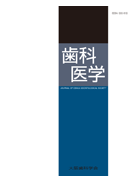Volume 60, Issue 3
Displaying 1-24 of 24 articles from this issue
- |<
- <
- 1
- >
- >|
-
Article type: Article
1997 Volume 60 Issue 3 Pages 173-183
Published: September 25, 1997
Released on J-STAGE: March 30, 2017
Download PDF (1319K) -
Article type: Article
1997 Volume 60 Issue 3 Pages 184-194
Published: September 25, 1997
Released on J-STAGE: March 30, 2017
Download PDF (1996K) -
Article type: Article
1997 Volume 60 Issue 3 Pages 195-204
Published: September 25, 1997
Released on J-STAGE: March 30, 2017
Download PDF (1097K) -
Article type: Article
1997 Volume 60 Issue 3 Pages 205-210
Published: September 25, 1997
Released on J-STAGE: March 30, 2017
Download PDF (761K) -
Article type: Article
1997 Volume 60 Issue 3 Pages 211-220
Published: September 25, 1997
Released on J-STAGE: March 30, 2017
Download PDF (945K) -
Article type: Article
1997 Volume 60 Issue 3 Pages 221-231
Published: September 25, 1997
Released on J-STAGE: March 30, 2017
Download PDF (1334K)
-
Article type: Article
1997 Volume 60 Issue 3 Pages 232-233
Published: September 25, 1997
Released on J-STAGE: March 30, 2017
Download PDF (282K) -
Article type: Article
1997 Volume 60 Issue 3 Pages 233-234
Published: September 25, 1997
Released on J-STAGE: March 30, 2017
Download PDF (201K) -
Article type: Article
1997 Volume 60 Issue 3 Pages 235-236
Published: September 25, 1997
Released on J-STAGE: March 30, 2017
Download PDF (323K) -
Article type: Article
1997 Volume 60 Issue 3 Pages 236-237
Published: September 25, 1997
Released on J-STAGE: March 30, 2017
Download PDF (326K) -
Article type: Article
1997 Volume 60 Issue 3 Pages 237-238
Published: September 25, 1997
Released on J-STAGE: March 30, 2017
Download PDF (263K)
-
Article type: Article
1997 Volume 60 Issue 3 Pages g1-g2
Published: September 25, 1997
Released on J-STAGE: March 30, 2017
Download PDF (275K) -
Article type: Article
1997 Volume 60 Issue 3 Pages g2-g3
Published: September 25, 1997
Released on J-STAGE: March 30, 2017
Download PDF (293K) -
Article type: Article
1997 Volume 60 Issue 3 Pages g4-g5
Published: September 25, 1997
Released on J-STAGE: March 30, 2017
Download PDF (267K) -
Article type: Article
1997 Volume 60 Issue 3 Pages g5-g6
Published: September 25, 1997
Released on J-STAGE: March 30, 2017
Download PDF (248K) -
Article type: Article
1997 Volume 60 Issue 3 Pages g7-g8
Published: September 25, 1997
Released on J-STAGE: March 30, 2017
Download PDF (263K) -
Article type: Article
1997 Volume 60 Issue 3 Pages g9-g10
Published: September 25, 1997
Released on J-STAGE: March 30, 2017
Download PDF (232K) -
Article type: Article
1997 Volume 60 Issue 3 Pages g11-g12
Published: September 25, 1997
Released on J-STAGE: March 30, 2017
Download PDF (286K) -
Article type: Article
1997 Volume 60 Issue 3 Pages g12-g13
Published: September 25, 1997
Released on J-STAGE: March 30, 2017
Download PDF (252K) -
Article type: Article
1997 Volume 60 Issue 3 Pages g14-g15
Published: September 25, 1997
Released on J-STAGE: March 30, 2017
Download PDF (296K) -
Article type: Article
1997 Volume 60 Issue 3 Pages g15-g16
Published: September 25, 1997
Released on J-STAGE: March 30, 2017
Download PDF (302K) -
Article type: Article
1997 Volume 60 Issue 3 Pages g17-g18
Published: September 25, 1997
Released on J-STAGE: March 30, 2017
Download PDF (284K) -
Article type: Article
1997 Volume 60 Issue 3 Pages g18-g19
Published: September 25, 1997
Released on J-STAGE: March 30, 2017
Download PDF (277K) -
Article type: Article
1997 Volume 60 Issue 3 Pages g20-g21
Published: September 25, 1997
Released on J-STAGE: March 30, 2017
Download PDF (266K)
- |<
- <
- 1
- >
- >|
